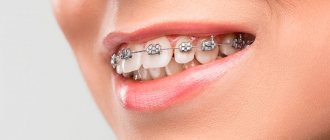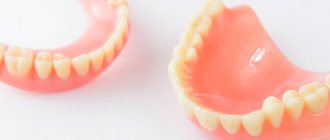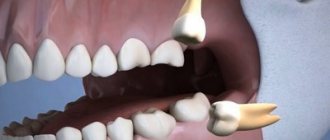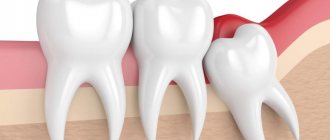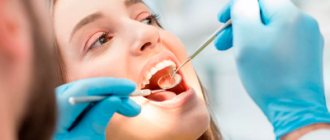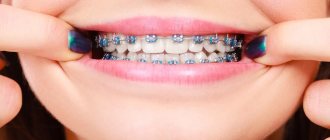Wisdom or 8 teeth can cause a lot of problems, especially if they grow into the cheek. These teeth have no analogues in the primary occlusion, so they erupt through unprepared periodontal tissue, and their growth is accompanied by discomfort even with proper eruption. The growth of eighth teeth can begin at age 17, but there are cases when these teeth remain impacted (not erupted) throughout life.
Symptoms and signs of abnormal growth
It is extremely rare for eights to appear without any complications. This is due, first of all, to the fact that wisdom teeth grow in adulthood, when the jaw is already formed. Even with proper teething, discomfort may still be present for several weeks or months. If a wisdom tooth grows incorrectly or has an abnormal location, then certain symptoms indicate this.
Let's take a closer look at the types of pathologies and symptoms associated with the growth of wisdom teeth.
- Retention is a pathology in which the third molar is located under the mucous or bone tissue. The main symptoms are severe pain in the gums, as well as the development of an inflammatory process in the gum pocket.
- Dystopia or abnormal position of the tooth. It manifests itself as severe pain, affecting adjacent teeth, and the development of inflammation, including phlegmon or osteomyelitis.
The initial alarming symptoms that a patient may identify when a wisdom tooth grows are:
- Swelling in the cheek area.
- When swallowing, severe pain occurs, radiating to the throat or ear.
- Purulent or bloody discharge.
- Injury to the mucous membrane.
If you detect at least one of the above symptoms during the eruption of figure eights, you must seek the help of a dentist as soon as possible. The doctor will conduct an x-ray and determine whether the wisdom tooth is growing correctly.
Useful recommendations for the postoperative period
During the process of tooth extraction, surrounding tissues are inevitably injured. In addition, the vacated hole represents an open wound. Therefore, it is so important to strictly follow the doctor’s instructions during the rehabilitation period, as well as monitor oral hygiene and the integrity of the blood clot formed in the socket. Otherwise, the risk of complications and alveolitis in particular will increase significantly.
If you ignore the doctor's recommendations, alveolitis may occur.
As a rule, experts provide the following recommendations for the rehabilitation period:
- refuse to eat in the first 2-3 hours after the procedure,
- do not touch the hole with your tongue or fingers,
- avoid intensive rinsing and anything that can create a vacuum effect in the mouth - to use antiseptic solutions, it is better to use oral baths,
- temporarily avoid visiting saunas and steam baths, hot baths and intense physical activity,
- take antibiotics, painkillers and other medications strictly as prescribed by the doctor,
- if the area where the tooth used to be hurts too much, swelling has increased and bad breath has appeared, as well as if a blood clot is damaged - in all these cases you need to urgently consult a dentist.
To somewhat reduce the intensity of pain after the procedure, the specialist will prescribe anti-inflammatory and painkillers, for example, Nimesil, Nise or Nimesulide. These medications are often prescribed after oral surgery. In addition, medications based on the active substance nimesulide have a moderate antipyretic effect, so they also help reduce temperature in the postoperative period1.
After the operation, the specialist prescribes anti-inflammatory and painkillers
Regarding whether it is necessary to remove a wisdom tooth, there is no clear opinion on this matter. In fact, these rudiments no longer carry any important functional load. On the other hand, if the upper or lower 8 grows vertically, and does not in any way affect the position of its “neighbors,” it is not at all necessary to remove it. In any case, the decision remains with the attending physician and is always based on the individual characteristics of the clinical picture.
- Bezrukov V.M., Sukachev V.A. Complications after tooth extraction, 2000.
What to do with a bothersome wisdom tooth at home
The most important thing is not to cause further harm to yourself before visiting the dentist. It is extremely important to avoid overheating the area of concern. Heat can accelerate the onset of the inflammatory process. Therefore, you should not apply warm compresses or take a hot bath.
What can you do to relieve pain when wisdom teeth erupt:
- follow a gentle diet (do not eat very hard, hot or cold foods);
- after eating, rinse your mouth;
- use local anesthesia, such as gels used during teething in children;
- In case of severe pain, you can take painkillers.
But the most important thing is not to delay your visit to a specialist! Only he will be able to determine the seriousness of the problem and help avoid possible complications.
Your feedback
I had my wisdom teeth removed at the RUTT clinic.
After six years of torment, during which he constantly made himself known at the most inopportune moments, she finally decided to break up with him. Removal was difficult (or so they said), with sawing and pulling out in parts. In terms of time, the doctor worked for at least 20-30 minutes. But it doesn’t feel like it hurts at all. Apart from picking at the jaw and pressing, I actually felt nothing. Unpleasant - yes, but not painful at all. Victoria |
10/31/2020 Leave a review Other reviews
Removal of abnormally growing eighth tooth
Very often, if the third molar grows abnormally, it is necessary to resort to its removal. Indications for surgery:
- Repeated cases of pericoronitis (purulent formation in the gum pocket). This problem most often occurs on the lower eights, which have not completely erupted. Pericoronitis is usually treated by removing the overhanging gum, but if the disease recurs, it is recommended to remove the offending tooth.
- The upper eight grows into the cheek, constantly injuring it. To avoid the formation of ulcers and infection of the oral cavity, as well as to prevent pain, wisdom tooth removal is required.
- The development of wisdom tooth dystopia was diagnosed. The tooth grows at an incorrect angle, which can lead to inflammation of the periodontal tissues and the development of caries on the eighth and neighboring teeth.
- The wisdom tooth grows to the side and affects the ternary nerve, causing attacks of pain. Most often, this occurs when an unerupted figure eight rests on the roots of neighboring teeth. Such an anomaly can only be diagnosed using an x-ray.
The procedure for performing the manipulation may differ depending on the location of the tooth. The sequence of the procedure during surgery:
- antiseptic treatment of the operating area;
- administration of anesthetic;
- tooth extraction;
- inserting a gauze swab into the hole to eliminate bleeding.
The tampon should be removed from the wound no earlier than after 25 minutes. The tampon must be in the socket to prevent bleeding. After the operation, the dental surgeon gives recommendations that must be strictly followed.
Method for removing a horizontally lying figure eight
Any position of a wisdom tooth identified as a deviation from the norm implies an unambiguous recommendation for complex removal. The operation falls into this category because it requires a series of traumatic actions for the patient to extract the tooth completely.
The intervention can be complicated by various unpleasant consequences, so before the operation the surgeon carefully prepares and calculates possible options for the development of the situation. An X-ray is mandatory.
Most dentists vote for early removal of the impacted figure eight. Over the years, the molar roots grow strongly and the jaw bones become denser, which prevents the tooth from being quickly removed from the socket. In youth, tissues are restored faster, and discomfort is experienced more easily.
However, the complexity of the operation is quite surmountable, and it occurs under strong anesthesia. The patient does not experience pain during removal.
Can you put a crown on a wisdom tooth?
Step-by-step method for extracting a horizontally located wisdom tooth:
- The use of an anesthetic, the drug “Ultracaine” is mainly used;
- Making an incision in the gum to expose an impacted wisdom tooth;
- If access to the roots is difficult, sawing the bone is necessary. The manipulation is performed extremely carefully, without the risk of damaging the adjacent tooth;
- Application of forceps and removal of the figure eight using loosening technology;
- When the third molar is in a recumbent position, the dentist first saws the tooth into pieces and removes them piece by piece;
- Suturing the incision on soft tissues with the application of a cotton-gauze swab. If self-absorbable suture material is used, no further treatment of the wound is required. In case of direct suturing, the sutures are removed at a doctor’s appointment in the clinic.
At the last stage of the operation, ice is applied to the extraction area, thus preventing the formation of severe swelling of the gums. The doctor discusses the possible consequences of the intervention: increased temperature, tissue soreness due to injury, bleeding. In this case, the normal limits are indicated, if exceeded, you should immediately contact the clinic.
Tooth restoration with a bridge
Restoring lost molars using a bridge is the second most popular restoration method.
Before the era of implantation, this was the most popular and virtually uncontested method of aesthetic prosthetics, but times and the quality of medicine are changing...
The technology of prosthetics with a bridge is as follows: let’s say one tooth is lost, the teeth adjacent to the missing one are designated as supporting teeth (bridge supports). The teeth are prepared - depulped, treated if necessary, and ground down for a crown. The structure, consisting of three crowns, is fixed on the supporting teeth, incl. and a lost tooth that does not have its own support. Modern preparation methods make it possible in some cases, when using a zirconium dioxide frame, not to depulpate the supporting teeth, but in some cases, after some time, patients may complain of increased sensitivity, and the nerve has to be removed.
The method of prosthetics with bridges is considered more affordable, however, as you will see below, when filling a single defect in the dentition, this statement is no longer so obvious.
The time for installing a bridge prosthesis (1-2 weeks) is significantly less than for treatment with implantation, but it has many disadvantages: the service life of a bridge prosthesis is 10-15 years, supporting teeth, which are often healthy, are ground down and injured when chewing or biting they experience increased stress on several teeth. The bone tissue in the area of the missing tooth is resorbed. After a few years, patients turn to the dentist with an aggravated problem, and then not only dental implantation will be required, but also bone grafting and soft tissue grafting.
The best way to fill a defect in the dentition is implantation
There are several technologies for dental prosthetics for partial loss. Today, the best way to restore teeth is implantation. This method is the most reliable (modern implants take root in 98-99% of cases, service life is more than 20 years and even a lifetime), the most aesthetic, functional and comfortable to use, because implants imitate the root of a tooth. It is also very important that during implantation there is no need to grind down adjacent healthy teeth.
The only thing better than implantation is your own tooth!
When a front molar is lost, implantation with immediate loading is often performed. With its help, the dentist immediately after installing the implant, without waiting for its osseointegration, installs a temporary crown that covers the aesthetic defect. The temporary crown is removed from the bite and is often bonded to adjacent teeth. After 2-6 months, the temporary crown is replaced with a permanent one. Immediate loading is carried out for aesthetic, not medical reasons. When a tooth is 100% subject to extraction (for example, with a longitudinal root fracture), but has not yet been removed, it is possible to perform an operation to remove the tooth and install an implant at the same time. In this case, the period of complete treatment is reduced by 3-4 months, and the cost is slightly reduced.
